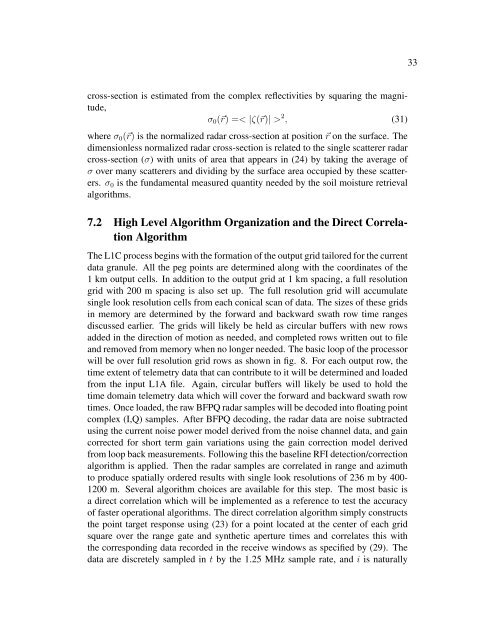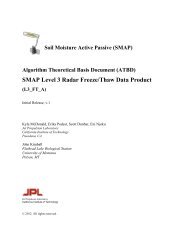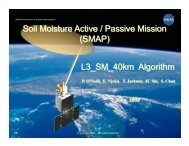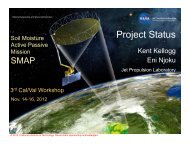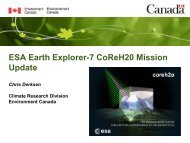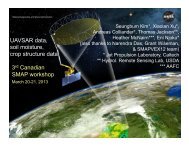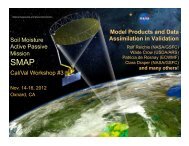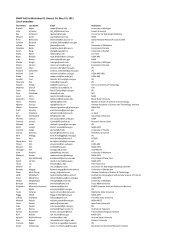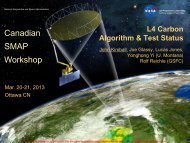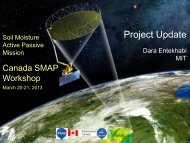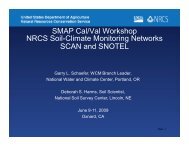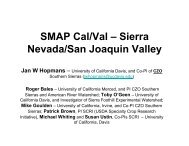(ATBD) SMAP Level 1 Radar Data Products - NASA
(ATBD) SMAP Level 1 Radar Data Products - NASA
(ATBD) SMAP Level 1 Radar Data Products - NASA
You also want an ePaper? Increase the reach of your titles
YUMPU automatically turns print PDFs into web optimized ePapers that Google loves.
33<br />
cross-section is estimated from the complex reflectivities by squaring the magnitude,<br />
σ 0 (⃗r) =< |ζ(⃗r)| > 2 , (31)<br />
where σ 0 (⃗r) is the normalized radar cross-section at position ⃗r on the surface. The<br />
dimensionless normalized radar cross-section is related to the single scatterer radar<br />
cross-section (σ) with units of area that appears in (24) by taking the average of<br />
σ over many scatterers and dividing by the surface area occupied by these scatterers.<br />
σ 0 is the fundamental measured quantity needed by the soil moisture retrieval<br />
algorithms.<br />
7.2 High <strong>Level</strong> Algorithm Organization and the Direct Correlation<br />
Algorithm<br />
The L1C process begins with the formation of the output grid tailored for the current<br />
data granule. All the peg points are determined along with the coordinates of the<br />
1 km output cells. In addition to the output grid at 1 km spacing, a full resolution<br />
grid with 200 m spacing is also set up. The full resolution grid will accumulate<br />
single look resolution cells from each conical scan of data. The sizes of these grids<br />
in memory are determined by the forward and backward swath row time ranges<br />
discussed earlier. The grids will likely be held as circular buffers with new rows<br />
added in the direction of motion as needed, and completed rows written out to file<br />
and removed from memory when no longer needed. The basic loop of the processor<br />
will be over full resolution grid rows as shown in fig. 8. For each output row, the<br />
time extent of telemetry data that can contribute to it will be determined and loaded<br />
from the input L1A file. Again, circular buffers will likely be used to hold the<br />
time domain telemetry data which will cover the forward and backward swath row<br />
times. Once loaded, the raw BFPQ radar samples will be decoded into floating point<br />
complex (I,Q) samples. After BFPQ decoding, the radar data are noise subtracted<br />
using the current noise power model derived from the noise channel data, and gain<br />
corrected for short term gain variations using the gain correction model derived<br />
from loop back measurements. Following this the baseline RFI detection/correction<br />
algorithm is applied. Then the radar samples are correlated in range and azimuth<br />
to produce spatially ordered results with single look resolutions of 236 m by 400-<br />
1200 m. Several algorithm choices are available for this step. The most basic is<br />
a direct correlation which will be implemented as a reference to test the accuracy<br />
of faster operational algorithms. The direct correlation algorithm simply constructs<br />
the point target response using (23) for a point located at the center of each grid<br />
square over the range gate and synthetic aperture times and correlates this with<br />
the corresponding data recorded in the receive windows as specified by (29). The<br />
data are discretely sampled in t by the 1.25 MHz sample rate, and i is naturally


